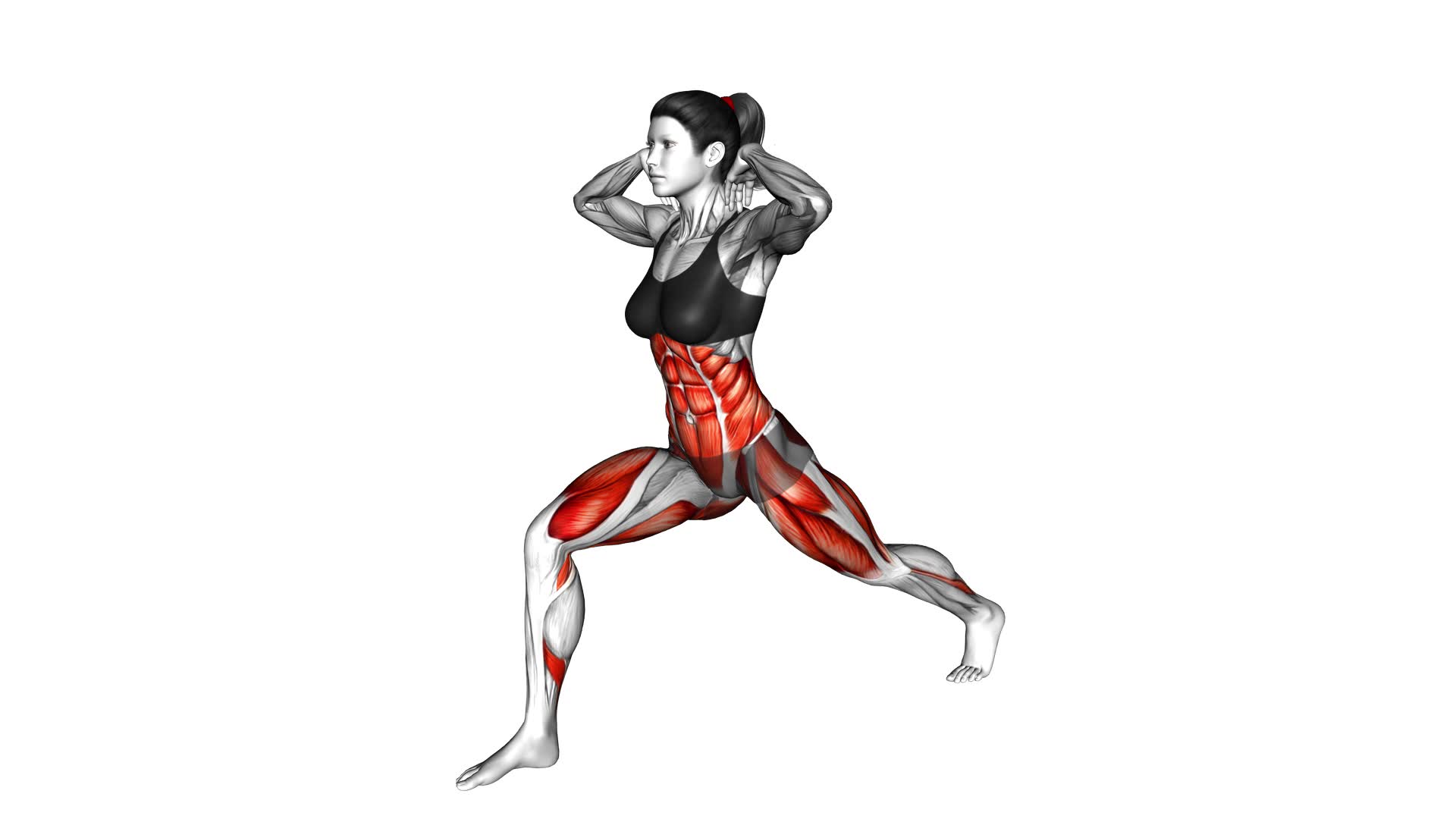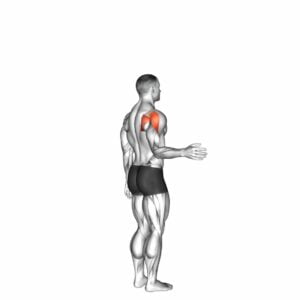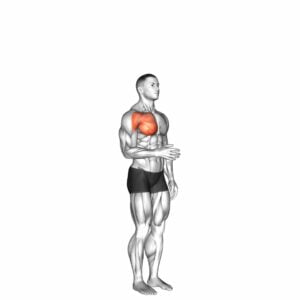Shoulder Rotation Twist Split Lunge Stretch (female) – Video Exercise Guide & Tips

Get ready to strengthen and stretch your muscles with the Shoulder Rotation Twist Split Lunge Stretch.
Watch This Exercise Video
This exercise is perfect for females looking to improve flexibility and tone their upper body.
In this video exercise guide, you’ll learn the proper form and technique, along with modifications for all fitness levels.
Avoid common mistakes and maximize the effectiveness of this stretch with helpful tips.
Incorporate the Shoulder Rotation Twist Split Lunge Stretch into your workout routine and feel the benefits today.
Key Takeaways
- Improves range of motion in the shoulders
- Targets deltoids, rotator cuff, and upper back muscles
- Engages core and lower body for stability and balance
- Enhances flexibility, balance, and strength
Benefits of the Shoulder Rotation Twist Split Lunge Stretch
What are the benefits of performing the Shoulder Rotation Twist Split Lunge Stretch?
This exercise has numerous benefits for your shoulder mobility and flexibility training. By incorporating the Shoulder Rotation Twist Split Lunge Stretch into your routine, you can improve the range of motion in your shoulders, allowing for better mobility and flexibility.
This stretch specifically targets the muscles in your shoulders, including the deltoids, rotator cuff, and upper back muscles. Regularly performing this stretch can help alleviate shoulder tightness and stiffness, which can be caused by poor posture, sitting for long periods, or repetitive movements.
It can also help prevent shoulder injuries by strengthening the muscles around the joint and improving their flexibility. Additionally, the Shoulder Rotation Twist Split Lunge Stretch engages your core muscles and lower body, particularly the hips, glutes, and quadriceps.
This adds an extra element of stability and balance to the exercise, helping to improve overall body coordination. Incorporating the Shoulder Rotation Twist Split Lunge Stretch into your flexibility training routine can lead to improved shoulder mobility, increased flexibility, and reduced risk of shoulder injuries.
Remember to warm up before performing this stretch and to consult with a professional if you have any pre-existing shoulder conditions.
Proper Form and Technique for the Exercise
To ensure you’re performing the Shoulder Rotation Twist Split Lunge Stretch correctly, there are a few common mistakes you should avoid.
These include not maintaining proper alignment, rushing through the movement, and not engaging your core.
By focusing on proper technique, you can maximize the benefits of this exercise.
These benefits include improved flexibility, balance, and strength.
Common Mistakes to Avoid
Avoiding common mistakes is crucial for maintaining proper form and technique while performing the Shoulder Rotation Twist Split Lunge Stretch. By avoiding these mistakes, you can prevent injuries and improve your flexibility effectively.
Here are three common mistakes to avoid:
- Not keeping your back straight: It’s important to maintain a straight back throughout the exercise to avoid straining your lower back and causing potential injuries.
- Overextending your front knee: Be mindful not to extend your front knee past your toes when lunging. This can put excessive pressure on the knee joint and lead to discomfort or injury.
- Neglecting proper alignment: Ensure that your front knee is directly above your ankle and that your back knee is aligned with your hip and shoulder. This will help you engage the correct muscles and prevent unnecessary strain on your joints.
Benefits of Proper Technique
By maintaining proper form and technique, you can enhance the benefits of the Shoulder Rotation Twist Split Lunge Stretch and reduce the risk of injury.
Proper technique is essential for maximizing flexibility and preventing injuries during this exercise. When performing the Shoulder Rotation Twist Split Lunge Stretch, it’s crucial to maintain a stable and balanced stance, ensuring that your knee doesn’t extend beyond your toes. This helps to protect the knee joint and prevent strain.
Additionally, maintaining a neutral spine and engaging your core muscles will help to stabilize your body and improve your balance. It’s also important to avoid excessive twisting of the shoulders and to focus on controlled movements to avoid strain or injury.
Modifications and Progressions for All Fitness Levels
Now let’s explore some modifications and progressions for individuals of all fitness levels.
If you’re a beginner, there are modifications available to help you ease into the exercise and build strength gradually.
On the other hand, if you’re more advanced, there are progression options to challenge you further and continue pushing your limits.
Whether you’re just starting out or looking to take your workout to the next level, we’ve got you covered with modifications and progressions tailored to your needs.
Beginner Modifications Explained
To modify this exercise for beginners, start by using a lighter weight or resistance band. This will help you focus on proper form and technique while gradually building strength and flexibility.
Here are some additional beginner modifications to consider:
- Reduce the range of motion: Take smaller steps or lunges to make the exercise more manageable.
- Use a stability aid: If you find it challenging to maintain balance, hold onto a wall, chair, or sturdy object for support.
- Perform the exercise without weights: Start by practicing the movements without any added resistance to perfect your form before adding weights.
Advanced Progression Options
To advance your workout and challenge yourself further, try incorporating these modifications and progressions into your fitness routine.
For advanced modifications, you can increase the intensity of the shoulder rotation twist split lunge stretch by holding a dumbbell or kettlebell in each hand. This will add resistance and make the exercise more challenging. Another option is to perform the exercise on an unstable surface, such as a BOSU ball or a balance board, to engage your core and improve stability.
For beginners or those who need alternatives, you can start by performing the exercise without weights and focus on mastering the form and technique. Additionally, you can reduce the range of motion by not going as deep into the lunge or by performing the exercise with your back knee on the ground.
Remember to listen to your body and choose the modifications that work best for you.
Common Mistakes to Avoid During the Stretch
One common mistake to avoid during the stretch is rushing through it without focusing on proper form and technique. When performing the Shoulder Rotation Twist Split Lunge Stretch, it’s important to pay attention to your body positioning and movements to maximize the benefits of the exercise and prevent injury.
Here are three tips for proper form to keep in mind:
- Maintain proper alignment: Ensure that your front knee is directly above your ankle and not extending past your toes. Your back leg should be straight, with your heel lifted off the ground. Keep your torso upright and avoid leaning forward or backward.
- Engage your core: Activate your abdominal muscles by drawing your belly button towards your spine. This will help stabilize your body and protect your lower back during the stretch.
- Control the rotation: As you twist your torso, focus on using your core muscles rather than relying solely on the momentum of the movement. Keep your hips facing forward and allow the rotation to come from your upper body.
Tips for Maximizing the Effectiveness of the Exercise
To maximize the effectiveness of the exercise, focus on engaging your muscles and maintaining proper form throughout the Shoulder Rotation Twist Split Lunge Stretch. By doing so, you can’t only maximize your flexibility but also prevent injuries.
First and foremost, it’s essential to engage your core muscles throughout the exercise. This will help stabilize your body and maintain proper alignment, reducing the risk of strain or injury. Additionally, focus on keeping your shoulders relaxed and down, as this will help you achieve a deeper stretch and prevent unnecessary tension.
Another tip for maximizing the effectiveness of this stretch is to pay attention to your breathing. Take slow, deep breaths as you perform the movement, inhaling through your nose and exhaling through your mouth. This will help you relax and release any tension in your muscles, allowing for a more effective stretch.
Lastly, listen to your body and go at your own pace. It’s important not to force the stretch or push yourself beyond your limits. Gradually increase the intensity and depth of the stretch over time, as your flexibility improves.
By following these tips, you can maximize the effectiveness of the Shoulder Rotation Twist Split Lunge Stretch, increasing your flexibility and preventing injuries.
Now, let’s explore how you can incorporate this stretch into your workout routine.
Incorporating the Shoulder Rotation Twist Split Lunge Stretch Into Your Workout Routine
To incorporate the Shoulder Rotation Twist Split Lunge Stretch into your workout routine, start by making sure you have enough space and a comfortable surface to perform the exercise.
This stretch is great for improving shoulder mobility and flexibility.
Here are three tips to help you seamlessly incorporate this stretch into your routine:
- Warm up: Before attempting the Shoulder Rotation Twist Split Lunge Stretch, it’s essential to warm up your muscles. Engage in light cardio exercises like jogging or jumping jacks to increase blood flow and prepare your body for the stretch.
- Proper form: When performing this stretch, it’s crucial to maintain proper form to avoid injury. Keep your back straight, engage your core, and ensure your front knee stays aligned with your ankle during the lunge. Additionally, focus on rotating your shoulders without straining your neck or back.
- Gradual progression: If you’re new to this stretch, start with a shorter range of motion and gradually increase it as your flexibility improves. Remember, it’s essential to listen to your body and avoid pushing yourself too hard too quickly.
Frequently Asked Questions
How Often Should I Perform the Shoulder Rotation Twist Split Lunge Stretch?
To optimize the benefits of the shoulder rotation twist split lunge stretch, it’s important to consider the frequency of performing this exercise. Without the context of the specific shoulder rotation twist split lunge stretch, it’s recommended to incorporate this stretch into your routine 2-3 times per week.
This frequency allows for adequate muscle recovery while still reaping the benefits of improved shoulder mobility, flexibility, and overall lower body strength.
Remember to always listen to your body and adjust the frequency as needed.
Can Men Also Benefit From Doing the Shoulder Rotation Twist Split Lunge Stretch?
Yes, men can definitely benefit from doing the shoulder rotation twist split lunge stretch.
This exercise helps to improve flexibility, balance, and mobility in the shoulder joints, which is beneficial for both men and women.
Additionally, there are variations of this stretch that can be tailored specifically for men, taking into account their unique anatomy and muscle imbalances.
Is It Normal to Feel Discomfort or Tightness During the Stretch?
Feeling discomfort or tightness during a stretch is quite common. It could be a sign that you’re pushing yourself too hard or not maintaining proper form. It’s important to listen to your body and make adjustments if needed.
Can I Perform the Shoulder Rotation Twist Split Lunge Stretch Without Any Equipment?
Yes, you can perform the shoulder rotation twist split lunge stretch without any equipment.
This exercise offers several benefits, such as improving shoulder mobility and flexibility, strengthening the lower body muscles, and increasing core stability.
If you find the stretch too challenging, you can modify it by reducing the depth of the lunge or using a chair for support.
Remember to listen to your body and stop if you feel any pain or discomfort.
Are There Any Specific Warm-Up Exercises I Should Do Before Attempting This Stretch?
Before attempting any stretch, it’s important to do a dynamic warm-up. This helps to increase blood flow and loosen up your muscles, reducing the risk of injury. Dynamic warm-up exercises like arm circles, leg swings, and high knees are great choices.
Additionally, stretching before exercise has many benefits, such as improving flexibility, enhancing performance, and preventing muscle soreness. So make sure to include a proper warm-up and stretching routine in your workout to maximize your results.
Conclusion
Incorporating the Shoulder Rotation Twist Split Lunge Stretch into your workout routine can provide numerous benefits.
This exercise helps improve shoulder mobility, stretches the hip flexors, strengthens the core, and enhances overall lower body flexibility.
By following proper form and technique, avoiding common mistakes, and gradually progressing in difficulty, individuals of all fitness levels can safely and effectively perform this stretch.
Maximize the effectiveness of the exercise by focusing on proper alignment and engaging the targeted muscles.

Author
Years ago, the spark of my life’s passion ignited in my mind the moment I stepped into the local gym for the first time. The inaugural bead of perspiration, the initial endeavor, the very first surge of endorphins, and a sense of pride that washed over me post-workout marked the beginning of my deep-seated interest in strength sports, fitness, and sports nutrition. This very curiosity blossomed rapidly into a profound fascination, propelling me to earn a Master’s degree in Physical Education from the Academy of Physical Education in Krakow, followed by a Sports Manager diploma from the Jagiellonian University. My journey of growth led me to gain more specialized qualifications, such as being a certified personal trainer with a focus on sports dietetics, a lifeguard, and an instructor for wellness and corrective gymnastics. Theoretical knowledge paired seamlessly with practical experience, reinforcing my belief that the transformation of individuals under my guidance was also a reflection of my personal growth. This belief holds true even today. Each day, I strive to push the boundaries and explore new realms. These realms gently elevate me to greater heights. The unique combination of passion for my field and the continuous quest for growth fuels my drive to break new ground.







